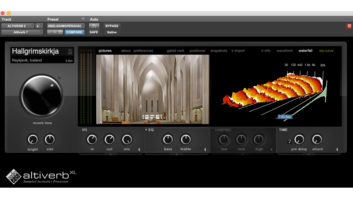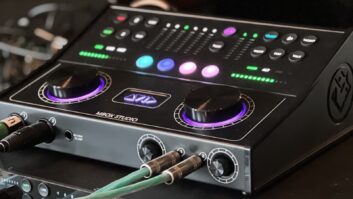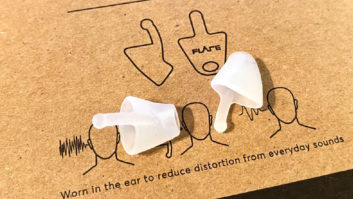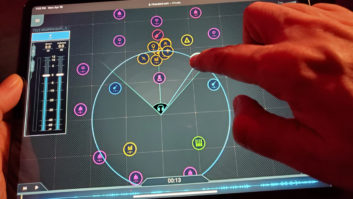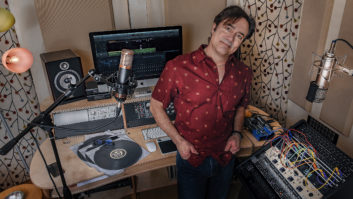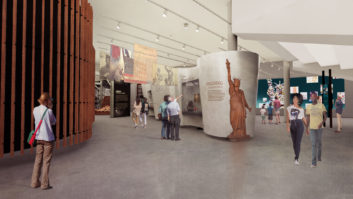
Convolution reverbs have brought new life and realism to the world of reverb. Convolution reverbs use impulse responses to extrapolate the acoustic characteristics of any environment. The Altiverb plug-in offers samples of real spaces from the Sydney Opera House to a fire truck cab, but “rolling your own” is where some creative fun begins.
Altiverb offers samples of real acoustic spaces, and lets users capture their own favorite environments.
MAKING IMPULSE RESPONSES
IRs are typically made two ways: the first method is playing a tonal sine sweep in any environment and recording it. The second method is firing a starter pistol in an environment and recording it. The recorded sweep (or gunshot) is loaded into the software, which analyzes the sound and models a reverb from it.
Sine Sweep: According to Audio Ease, using the sine sweep method is the most accurate method of reproducing the natural reverb of an environment. Altiverb has a sweep generator that will make an audio CD you can play on location. Be aware, though, that the software is finicky and requires that you record the head tone, the sweep, the silence that follows, and the tail tones for the software to do its job. On Superman Returns, we recorded a set of large spaces using JBL powered speakers and four Schoeps cardioid microphones in a dual ORTF configuration to get some great quad ‘verbs.
Starter Pistol: This approach is useful for very big or remote environments like canyons, where lugging speakers powerful enough for big distances is cumbersome. However, in my experience, any sound that makes a crack and decay can be used. CO2 pistols give a nice round sound, often translating better for voices than their sharper counterparts. Clapper boards and even balloon pops achieve great results as well, and these are particularly recommended when recording in public locations where a gun might lead to legal complications.
Any of the above methods can create very realistic sounding reverbs, but let’s focus our attention to some of the more unrealistic possibilities — specifically, how to use Altiverb to achieve otherworldly sounds.
MANIPULATING IMPULSE RESPONSES
I often manipulate the impulse responses before loading them into Altiverb; I’ll EQ out hums and do noise reduction with Waves X-Noise before using a new IR. But why stop there? Try pitching down an IR to create longer, deeper reverbs. Altiverb features a Room Size dial next to its Reverb Time dial; adjusting this knob will actually adjust the pitch up or down.
In fact, any sound can be used as an impulse response. This allows Altiverb to be used as a powerful sound design tool, not merely as a reverb device. Try replacing your starter pistol crack with an explosion, a thunder roll or a wave crash and you’ll get some pretty insane results. I’ve run dialog through Altiverb using an underwater bubble as an IR to simulate underwater voices. On Superman Returns, we used the “ding” of a crystal vase as an IR for Marlon Brando’s voice to resonate his dialog in the Fortress of Solitude. The “glassiness” of the crystal convoluted with Brando’s voice creates an ethereal chime that matches his vocal inflection but sounds like it might be emanating from inside the crystal cavern’s walls.
Try using the gear clicks of a ratchet as an IR to create a mechanistic voice or effect, or a computer beep to go robotic. A bumblebee’s buzz or wind whistle will render other wacky results.
Altiverb’s Reverse button is another great tool for manipulating IRs. Click this to reverse your IR sample. This is often useful if you want to ramp into a sound, and its effect on an IR is no different. For example, if you use a thunder crack as an IR and reverse it, running a sound through Altiverb will create a “whoosh” effect. The tail of the thunder builds as we ramp up to the attack, creating the sense of building power that’s very different from simply reversing the sound itself.
SURROUNDED BY ‘VERB
You can even generate your own exotic pans (stereo or surround) with the IRs you make, creating your own surreal reflection patterns. Try some funky quad panning with your sound before loading it into Altiverb as an IR. Swirl your sound around the room with a surround panner and bounce it down to a quad set of files, each with the appropriate “.1,” “.2,” “.3” and “.4” extensions for Altiverb to interpret. When you run your sounds through this quad IR, they’ll swirl around you in the same pattern. Sometimes, long decay tails will muddy up these intricate moves, so you may need to trim the tail down in Altiverb using the Reverb Time dial in the main screen or Reverb Tail Gain under the Damping & Gains screen.
DON’T LET YOUR ‘VERB PERTURB
The Altiverb Forum at www.audioease.com is a great resource for solving problems and getting new ideas. There’s also a treasure trove of free impulse responses available for download.
Altiverb will put sounds in great, realistic spaces. But a little experimentation will yield some exciting and unexpected results.
Erik Aadahl was a sound designer on Superman Returns.
